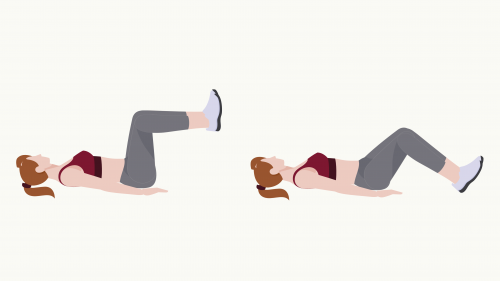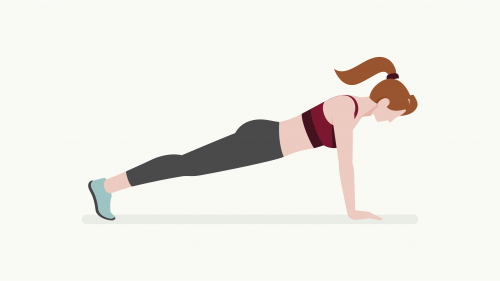How to Engage and Strengthen Your Core
The fitness aspect of Mountain Trek’s program is broken down into five important components: flexibility, cardio, strength, core stability, and of course, fun. Here we’re going to focus on your core muscles, what they are, what they do, and how to strengthen them.
Strength training is all about building lean muscle mass to help raise your basal metabolic rate (BMR) and create a favorable metabolic environment for fat loss. As we age, we’re prone to muscle loss. A 50-year-old person can lose 0.4 pounds of muscle every year. Compound that with muscle loss due to a sedentary and inactive lifestyle, and we start storing more calories than we’re burning.
By strengthening our muscles we burn more calories. Specifically, 1 lb of muscle burns 6 calories per day just resting versus 1 lb of adipose (fat) at 2 calories per day.
In today’s modern world, many of us find ourselves sitting for prolonged amounts of time; whether at our office desks, in planes, or during our daily commute. This sedentarism is not good for our core muscles, nor is it good for our bodies overall. (Read more about the dangers of sitting in our article “Why sitting is bad for you and 5 ways to fix it.”)
The good news is there are easy exercises we can do to curb this sedentarism and strengthen our core muscles, ensuring we maintain good posture and avoid injury.
WHAT ARE YOUR CORE MUSCLES?
When most people think “core muscles” they envision six-pack abs like the kind you’d find on a Calvin Klein model. But the fact is your core is a series of muscles that extend far beyond your abdominals and include most everything in your torso.
Your core is more than just your abdominals, which is a commonly exercised muscle group. The core muscles beneath the surface include:
- Transverse abdominals
- Multifidus
- Diaphragm
- Pelvic floor
- Internal and external obliques
- Erector spinae
- Latissimus morsi (the “lats”, and the biggest muscle in the upper body)
- Trapezius (“traps”)
And even the gluteus maximus is included in the core muscle group.
WHAT DO YOUR CORE MUSCLES DO?
The core is incorporated in almost every movement of the human body. These muscles can act as an isometric or dynamic stabilizer for movement, transfer force from one extremity to another, or initiate movement itself.
By reclaiming the stabilizing muscles of posture, balance, and power, we help prevent ourselves from falling and causing injury to other parts of our body, including our spine. In fact, many people in today’s society suffer from back pain, largely because their core muscles have atrophied and their spines and skeletons are forced to bear the brunt of their movement.
HOW DO YOU STRENGTHEN YOUR CORE MUSCLES?
At Mountain Trek, we offer fitness classes specific to strengthening the core group of muscles using a mix of some or no equipment. These exercises can be done anywhere, without equipment. It’s important to remember to always warm-up before by doing some light yoga poses and/or jumping jacks and shoulder rolls. It also helps to have a yoga mat underneath you for many of these.
1. Horse Stance

- Begin on all fours, with your hands directly beneath your shoulders, and your knees directly below your hip sockets.
- Keep your back straight, and look directly down at the ground.
- Engage your core. Exhale sharply, feeling your belly button pull to your spine. Maintain this engagement throughout the exercise.
- Lift one hand and the opposing leg, maintaining a straight arm and knee. Lifting only as high as you can to maintain your posture. Hold for 5 seconds.
- Lift your leg with your glute so you don’t arch your back. And keep your shoulders away from creeping up to your ears.
- Switch to the other hand and leg and repeat 5 times.
- Breathe throughout!
2. Leg Drops

- Lie on your back, with your knees bent at 90-degrees directly above your hips. Also known as “tabletop” in pilates.
- Keep your hands down beside your hips for support.
- Exhale sharply to engage your core and feel your lower back touch the ground. Maintain this engagement throughout the exercise.
- Lower your legs, keeping the 90-degree angle, only as far as you can keep your lower back touching the ground. Then using your core strength, bring your knees back up to “tabletop”.
- If your heels meet the ground, lightly touch and draw your knees back upright.
- Keep the movement slow. Repeat 10 times.
- Should you feel fatigued, or cannot keep your lower back touching the ground, do one leg at a time. Or, if you need a challenge, straighten your legs to lower and lift.
3. Plank

- Start in on all fours; like for horse stance, make sure your arms are directly beneath your shoulders.
- Step one foot back at a time so that your heels are directly above your ankles.
- Maintain a straight line from your head, along your spine, to your ankles. To achieve this: engage your core, draw your belly-button to your spine and squeeze your glutes.
- Look straight down at the ground, and not at your toes to maintain your straight spine.
- Hold for as long as you can, then lower your knees for 10 seconds and repeat 10 times.
- If this hurts your wrists, or you begin to get tired, lower to your elbows and/or your knees.
How to Engage your Core
When we want to strengthen our core, all of the exercises direct us to “engage your core”. How do we do that? This video will guide you through the steps, actions and key indicators to properly engage your core muscles.
What is Mountain Trek?
Mountain Trek is the health reset you’ve been looking for. Our award-winning retreat, immersed in the lush nature of British Columbia, will help you unplug, recharge, and roll back years of stress and unhealthy habits. To learn more about the retreat, and how we can help you reset your health, please email us at info@mountaintrek.com or reach out below:


